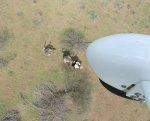Here's a method to work up to those "hook" landings to turn into the wind close to the ground comfortably. Once you get your feel and confidence, it is fun.
At 10' AGL, on a normal approach, flare too high on purpose and add throttle to just keep you airborn. Fly a good distance at this attitude, altitude and speed, adding and removing throttle to just maintain flight and height. When you are comfortable with this maneuver, come in for a normal landing, flare fully at your normal height just off the ground, and add FULL throttle rapidly, keeping the nose high and hang from the prop as long as you can manage, then gradually drop the nose and gain air speed and take off again. You should have already learned this from your CFI at high altitude. THe only difference now is that you are doing it below 10ft AGL. If you have an engine failure at this low height you should be OK. Dont' do it between 10-200 ft AGL under any circumstances.
This gets you comfortable with the use of throttle to control close-ground encounters and hard landings while training for the next step - hook landings, turning into the wind from a few feet off the ground.
First, you need to be very comfortable flying very close to the ground to begin with, and that just takes regular practice. Start your intended ground maneuvers high up, and gradually decrease the turn radius until you are comfortable with a figure eight that will easily fit inside the intended practice field. Under calm wind conditions, do tight ovals over the field. Each time, get a little bit lower. At just above tree-tops, like 50-100 AGL, form a figure 8 that will fit inside the "box", then change the pattern to a simple oval. That way you know that if you can make a transitional turn, as in an "8", then you can quite easily do the oval.
Soon you will be comfortable turning and flying easily at 15-20 ft AGL, and you can start doing the "8" at this height. Next step is to do this in light winds, no more than 5 MPH. A low-time pilot should not be flying below tree top in winds higher than this, so that it is easy to just step-climb up over any danger if you slip too far while turning.
When you feel like you have mastered your senses flying this low in light winds, the next step is to practice high-speed taxiing, very low. This includes all turns over the runway approaches, and the taxiway, if you have those.
Next, on a day with a 5 mph x-wind, approach as normal, and as you start to round out at the bottom of your approach, add throttle to maintain minimum flight speed. Fly very low long enough to achieve straight and level flight maintenance. Now just turn into the wind, reducing throttle smoothly and in coordination with letting the ground come to meet you, then flare as you always do and voila, you have done a 90* hook landing into the wind.
The final step is to fly downwind, and do a 180* back into the wind and land.
These are relatively "light stick" maneuvers, and you are not turning all that tight when compared to a hammerhead turn.
When there is no power, it is very easy to "throw" the stick left or right, and use pedal to do a coordinated turn to do a 180 on a dime. You lose very little, or even no appreciable altitude doing this maneuver. Imagine it in your head first, for a day or two. Take a lesson to learn it at high altitude. Then gradually do it lower and lower, until you can land like Birdy does in that video of his where he hooks a landing coming around the corner of his barn at 1-2 meters AGL.



